Unit #5/6: Pure Tone Anatomy + Protocol + Crossover/Crosshearing + Masking Diagram | Quizlet
1/99
There's no tags or description
Looks like no tags are added yet.
Name | Mastery | Learn | Test | Matching | Spaced |
|---|
No study sessions yet.
100 Terms
what are the characteristics of air conduction?
- sound passes through OE to ME to IE.
- an example is, listening to me speak right now in the classroom.
what are the characteristics of bone conduction?
- sound directly stimulates the IE via the skull-bones.
- ex: tap gently on the back of your skull or on your forehead.
(bypassing the outer ear and middle ear)
lesions can occur at which 5 sites?
- OE
- ME
- IE (cochlea)
- vestibule-coclear (VIII) nerve
- CANS (nuclei beyond the cochlea)
HL in the OE only is ___?
- conductive (OE).
HL in the ME only is ___?
- conductive (ME).
HL in the OE + ME ___?
- conductive (OE + ME).
HL in the cochlea is ___?
- sensorineural.
HL in the vestibulo-cochlear nerve is ___?
- neural (VCN).
HL in the cochlea + vestibulo-cochlear nerve is ___?
- sensorineural (C + VCN)
HL in OE/ME + IE is ___?
- mixed.
HL in the CANS is ___?
central.
two causes of conductive HL?
- otitis media + stenosis.
two causes of SNHL?
- meineres + ototoxicity.
- two causes of mixed HL?
- otosclerosis (later stage) + damage to IE.
identify the type of HL for each: 1) impacted wax, 2) anotia, 3) stenosis, 4) otitis externa, 5) otitis media, 5) otitis interna, 6) otosclerosis
- conductive.
- conductive.
- conductive.
- conductive.
- conductive.
- sensorineural.
- early: conductive, later: mixed.
what is intensity?
- loudness.
what is frequency?
- pitch (low versus high).
the average, young, healthy human ear can hear ___?
- frequencies: 20-20,000 Hz.
- intensities: 20 micro pascals (pressure) or 0 dB SPL to 200,000,000 (20 x 107) micro pascals or 150 dB SPL
(SPL: sound pressure level)
what does the minimum audibility curve show?
- that the sensitivity of the human ear is different across different frequencies.
- it represents the dB SPL threshold (the softest sounds that can be detected 50% of the time)
- dB SPL to dB HL
audiologists are typically interested in assessing the speech frequency octaves ___?
- 250-8000 Hz.
acousticians and audiologists have created a conversion chart at each frequency (hz), displaying ___ to ___?
- dB SPL to dB HL (allowing for the data to be seen on a "flat scale" so its easy to understand what's normal.
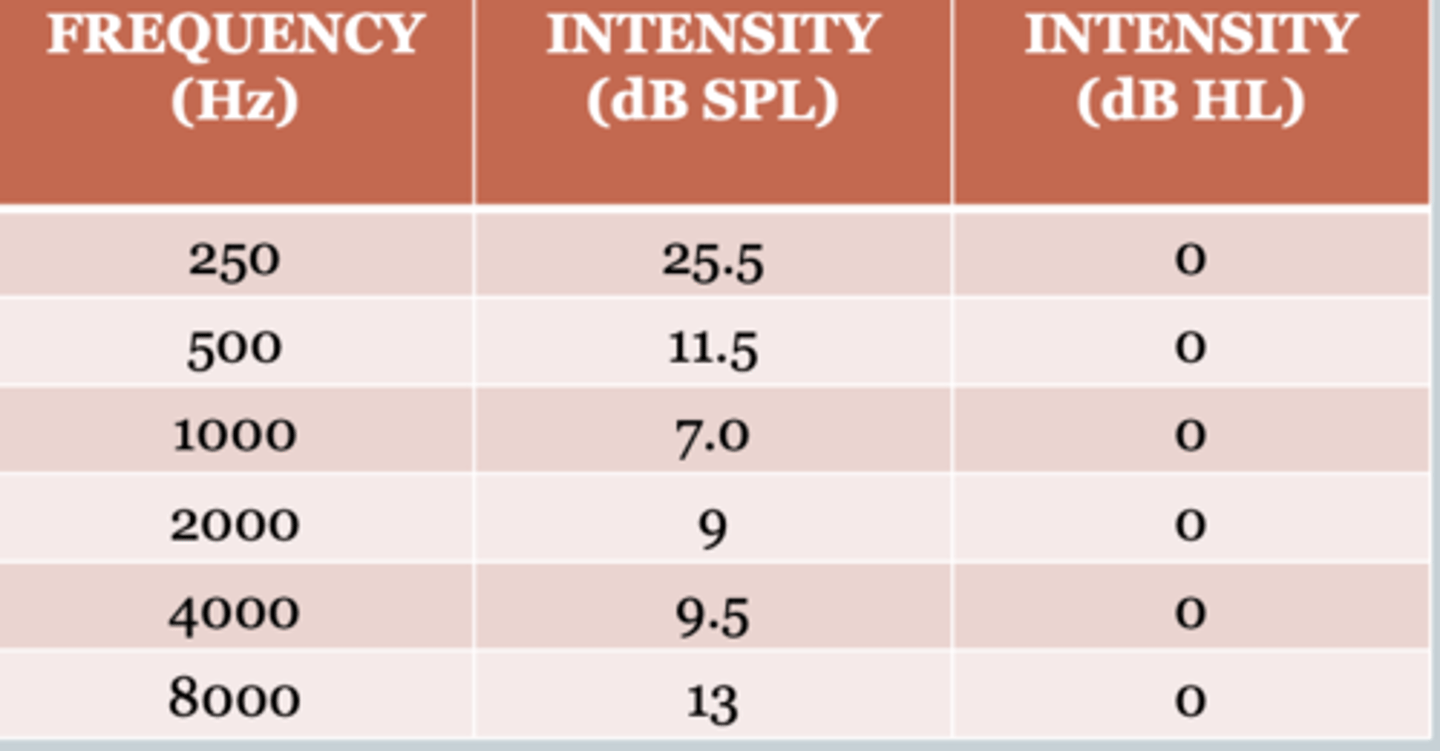
what are the advantaged of the dB HL scale?
1. easy to understand what is normal.
2. when you know what is normal, its easier to study the atypical.
3. math operations can be easily performed: 50dB HL - 45 dB HL = 5 dB.
-- dB HL is used in the clinics.
what is pure tone audiometry?
- a basic and vital hearing test for assessing hearing thresholds of adults and children.
- 1. the stimuli used are pure tones.
2. pure tones are presented at different frequencies and intensities.
3. the patient is asked to respond every time they hear a sound.
4. the softest sound that the patient hears 2/3 times is noted down as their threshold for a particular frequency.
what are the basic goals of pure tone audiometry?
- determine pure tone threshold:
lowest level at which we can hear a pure tone at least 50% of the time.
- evaluate thresholds across frequencies:
determine configuration of hearing loss.
- evaluate sensitivity of air and bone conduction pathways.
- test each ear individually.
what are the functions of pure tone audiometry?
- determine presence of hearing loss (Is there a hearing loss or is the hearing sensitivity within normal limits?).
- determine the degree of hearing loss (mild, moderate, moderately-severe, severe, profound).
- determine type of hearing loss (conductive, sensorineural, or mixed).
what are some basic components of an audiometer?
oscillator: - generates pure tones from 250 - 8000 Hz.
- generates noise with different frequency ranges (narrow band, wide band, speech-shaped).
amplifier: - amplifies pure tones covering a typical range of -10 dB HL to 110 dB HL (depending on frequency and transducer)
attenuator: - simply, a volume control calibrated in dB HL values.
interrupter: It is a button for presenting the pure tone signal to the patient.
what are the different transducers?
- headphones.
- insert earphones.
- bone conduction oscillator.
- loudspeakers.
OTHERS:
- microphone: for generating live speech signals
- auxiliary input (e.g., CD): for presenting pre-recorded signals
diagnostic tests can occur in what two forms?
- a two-room set up.
- a one-room set up.
what are the steps for hearing procedure testing?
1) the patient is seated in the test room. They need to be alert and attentive throughout the procedure.
2) the audiologist provides testing instructions:
-- the patient will hear a sound/tone.
-- the tones may get louder or softer.
-- when the tone is heard, the patient must indicate this to the audiologist (raising hand, pressing a button, saying yes/no).
-- the task of the patient is to respond even to the softest sound that they hear and not to respond when they do not hear.
3) the softest sound that the patient detects at least 50% of the time (2/3) is their threshold at that frequency.
4) all octave frequencies from 250-8000 Hz are tested in the same fashion.
5) each ear is individually tested.
6) both air conduction and bone conduction thresholds are obtained in this way.
what are three limitations of pure tone audiometry?
- can't identify specific/exact site of lesion.
- can't describe effects of hearing loss on everyday communication.
- is subjective.
what is an oscillator?
- generates pure tones from 250 - 8000 Hz.
- generates noise with different frequency ranges (narrow band, wide band, speech-shaped).
what is an amplifier?
- amplifies pure tones covering a typical range of -10 dB HL to 110 dB HL (depending on frequency and transducer)
what is an attenuator?
- simply, a volume control calibrated in dB HL values.
what is an interrupter?
- It is a button for presenting the pure tone signal to the patient.
what is typical audiometric testing environment?
- audiometric testing is performed in a SOUNDT REATED room/booth.
- one of the basic purposes of testing in such an environment is to prevent noise or any electrical activity from the outside environment to cause interference with threshold estimation.
patient response issues: what are false positives? why would the patient do this?
- raising the hand when no tone is presented.
- expected pattern.
- tinnitus that is same frequency as a pure tone.
- instructs are not clear (re-instruction must our).
patient response issues: what are false negatives? why would the patient do this?
- not responding when tone heard.
- malingering (faking hearing loss).
for PTA protocol which ear is tested first?
- start testing the better ear, as indicated by the patient.
- if the patient indicates no difference between ears, start testing the right ear.
for PTA protocol, which modality first?
- test air conduction first and then bone conduction.
for PTA protocol which frequency is tested first?
- start testing at 1000 Hz.
- then test at higher octaves i.e., 2000, 4000, and 8000 Hz.
- then, re-test at 1000 Hz.
- finally, test at 500 and 250 Hz.
- repeat procedure for the other ear.
when should mid-octave frequencies be tested?
- test mid-octave frequencies when threshold difference b/w octave.
- the mid-octave frequencies are 750, 1500, 3000, 6000 hz.
what is step one to determine a pure tone threshold?
- find starting level for bracketing.
- present tone at 30 dB HL.
- if the patient can't hear increase by 10 dB.
- if the patient can hear decrease by 10 dB.
- the patients starting level is the highest level that they did not hear sound.
what is step two to determine a pure tone threshold?
- conduct bracketing threshold search.
- begin "down 10, up 5" bracketing procedure at the starting level.
- following a positive response, reduce intensity by 10 dB.
- following a negative response, increase intensity by 5 dB.
- continue down 10, up 5 bracketing process until you identify the patient's threshold.
- threshold is the lowest level at which the subject responds at least 50% of the time (2/3 times).
TERM
what is right ear, air, unmasked?
DEFINITION
o
TERM
what is right ear, bone, unmasked? (opens to the right)
DEFINITION
<
TERM
what is left ear, air, unmasked?
DEFINITION
X
TERM
what is left ear, bone, unmasked? (opens to the left)
DEFINITION
>
TERM
what is right ear, air, masked?
DEFINITION
△
TERM
what is left ear, air, masked?
DEFINITION
□
TERM
what is right ear, bone, masked? (opened to the right)
DEFINITION
[
TERM
what is left ear, bone, masked? (opened to the left)
DEFINITION
]
what is protocol for air and bone conduction?
- air conduction in the right ear for all frequencies (250 Hz – 8000 Hz).
- air conduction in the left ear for all frequencies (250 Hz – 8000 Hz).
- bone conduction in the right ear for frequencies (500 Hz – 4000 Hz).
- bone conduction in the left ear for frequencies (500 Hz – 4000 Hz).
what is the air bone gap?
- the amount of sound energy (in decibels) by which the air-conduction threshold exceeds the bone-conduction threshold.
how do you calculate the ABG?
unmasked AC - masked BC
practice ex:
- AC threshold at 500 hz = 50
- BC threshold at 500 hz = 25
- what is the difference between AC and BC = 25

what is the pure tone average?
- the average of a patient's thresholds obtained at 500, 1000, and 2000 Hz in each ear.
how do you calculate PTA?
- do each ear independently, add up all frequencies from 500, 1K, and 2K, then divide by 3.
practice ex:
- AC left ear: 10+15+30/ 3 = 18.333 dB HL
- AC right ear: 50+25+30 / 3 = 35 dB HL
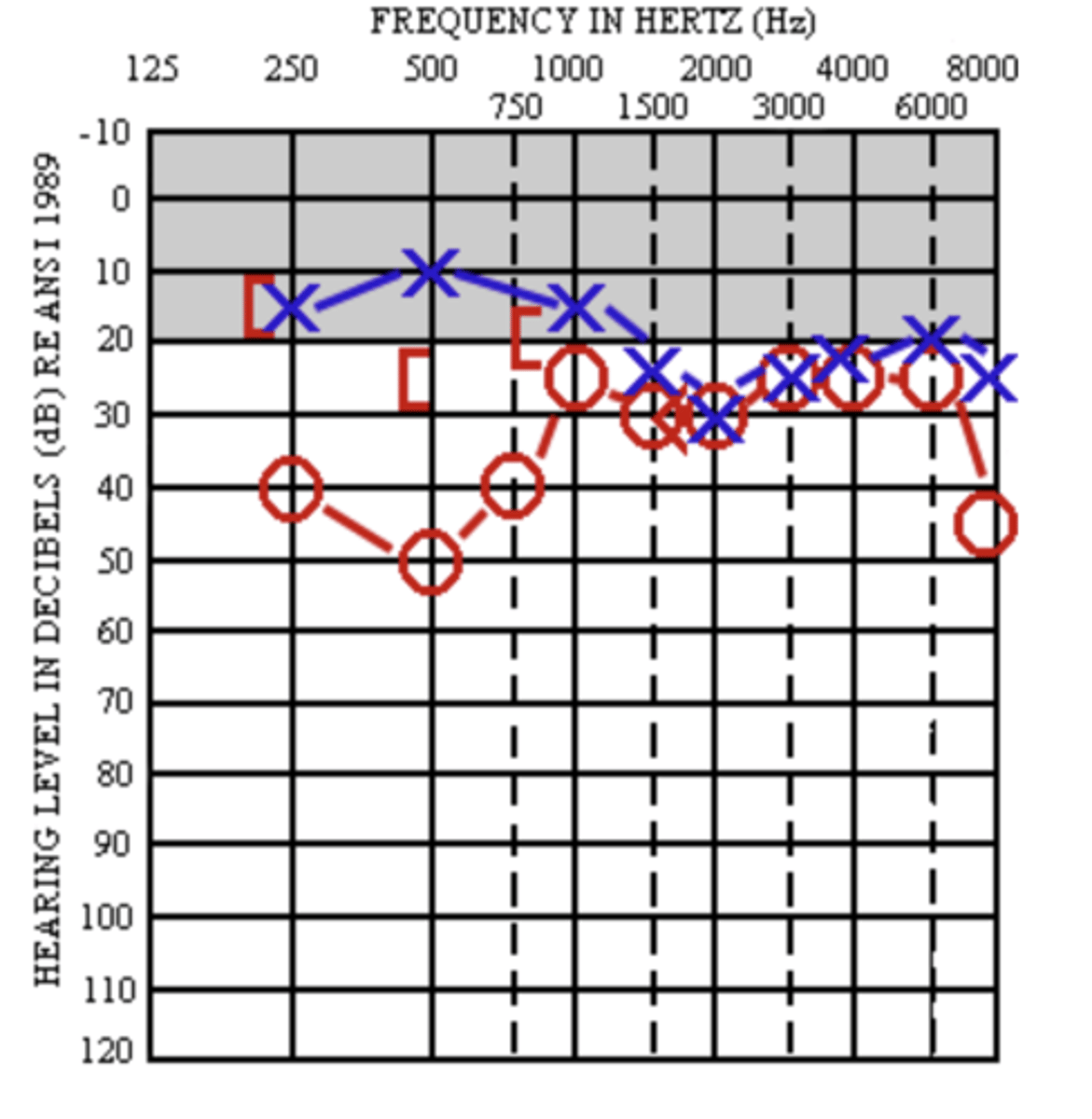
what are the characteristics of infant testing?
- VRA: visual reinforcement audiology.
- a toy lights up when audio is played from loud speaker, toy lighting up elicits conditioned response.
- what is the drawback of the loud speaker? it lacks ear specific information.
what is an otoscopy?
- visual examination of TM health.
- observation of wax production.
what are the characteristics of children's play audiometry? also, what are the steps to conducting such a visit?
- conducted in a one-room set up.
- child either wears insert earphones or audio is displayed on loud speaker. when the tone is heard, the child will place down the block.
- "free field" is a loudspeaker.
- "closed field" is insert earphones or other transducer.
steps:
- take case history.
- 2. tymponometry (to observe ear drum movement/if ME is working well)
- 3. otoscopy
- 4. play audiometry.
what are the characteristics of adult PTA? also, what are the steps to conducting such a visit?
- find threshold, use better ear, go from 1K, 2K, 4K, 8K, 1K, 500K, 250K.
- start at 30 dB, negative response +10, positive response -10, find starting level.
- now use starting level for bracketing, if negative response +5, of positive response -10.
- after a few tries the dB that occurred 2/3 (50%) of the time is the threshold at that specific frequency, now move onto the next frequency.
steps:
- case history.
- otoscopy.
- tymponometry (ME function)
what are some rules for bone conduction testing?
- we are not testing frequencies 250 & 8K.
- BC testing occurs on the mastoid of the better ear on 500, 1K, 2K, and 4K frequencies.
when should you make use of the mid-octaves?
- more than 20 dB HL.
- the mid-octaves are (750, 1500, 3000, and 6000)
what does 0 dB HL mean?
- normal hearing.
- theoretically, if a threshold is greater than 0 dBHL, the individual has a hearing loss.
what constitutes as a hearing loss for adults?
> 25 dB HL.
what constitutes as a hearing loss for children?
> 15 dB HL.
what is the traditional method to determine PTA?
- average threshold at 500, 1000, and 2000 Hz.
-- example: 500 Hz = 25 dBHL; 1000 Hz = 35 dBHL; 2000 Hz = 45 dBHL; PTA = 25+35+45/3 = 105/3 = 35 dB HL
what is the method to determine PTA of high frequencies?
- average threshold at 500, 1000, 2000 and 4000 Hz.
-- example: 500 Hz = 25 dBHL; 1000 Hz = 35 dBHL;2000 Hz = 45 dBHL; 4000 Hz = 55 dBHL; HFPTA= 25+35+45+55/4 = 160/4 = 40 dB HL.
what are the degrees of hearing loss for children?
≤ 15 = normal (less than or equal to)
16 - 25 = slight
26 - 40 = mild
41 - 55 = moderate
56 - 70 = moderately-severe
71 - 90 = severe
> 90 = profound
what are the degrees of hearing loss for adults?
≤ 25 = normal (less than or equal to)
26 - 40 = mild
41 - 55 = moderate
56 - 70 = moderately severe
71 - 90 = severe
> 90 = profound
can you find the PTA of this 7 y.o./F?
500 Hz = 15 dB HL
1000 Hz = 10 dB HL
2000 Hz = 25 dB HL
4000 Hz = 55 dB HL
PTA?
HFPTA?
answer:
(PTA = 16.7 dB HL) - slight hearing loss
(HFPTA = 26.25 dB HL) - mild hearing loss
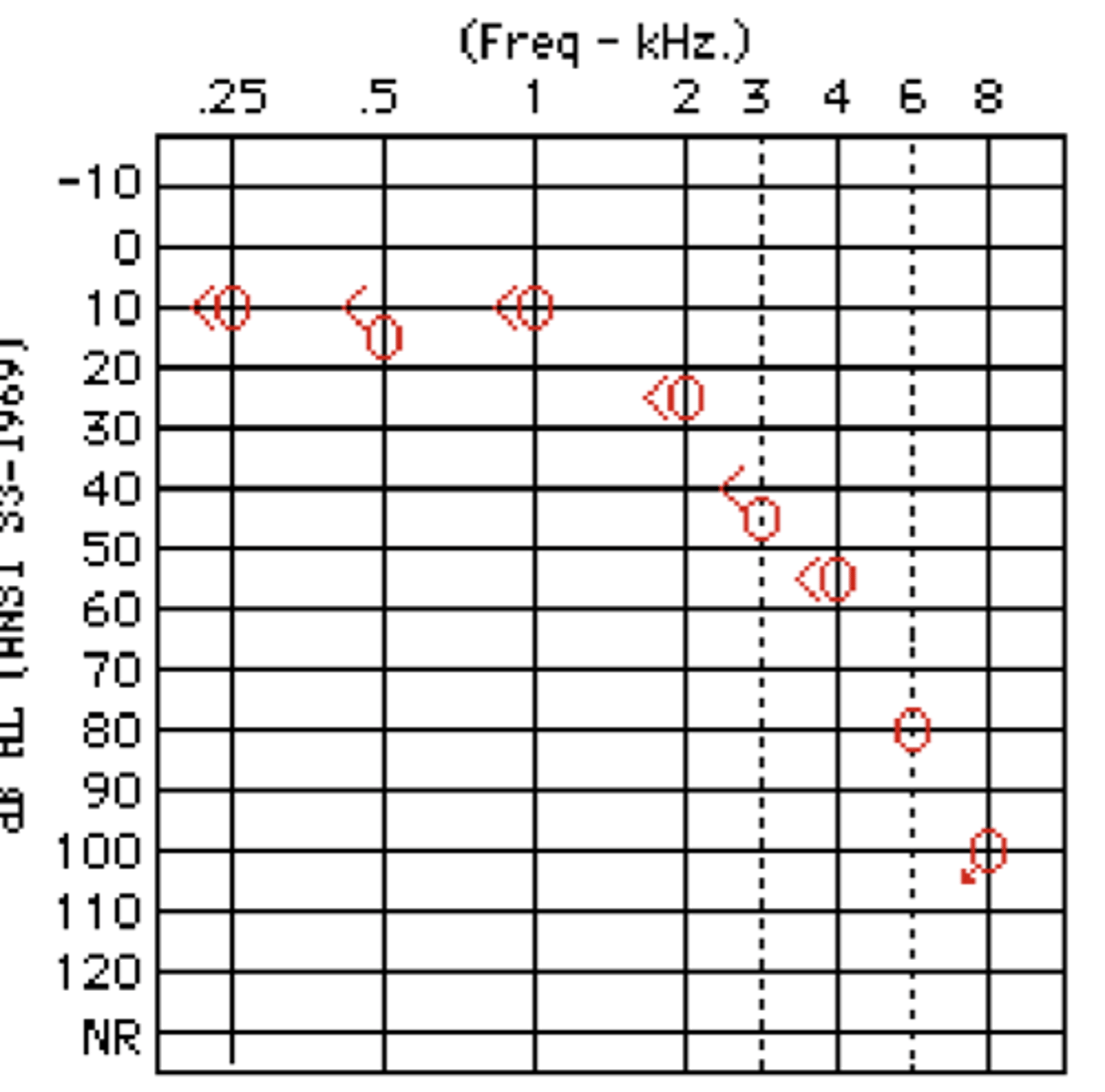
can you find the PTA of this 35 y.o./M?
500 Hz = 35 dB HL
1000 Hz = 30 dB HL
2000 Hz = 40 dB HL
4000 Hz = 35 dB HL
PTA?
HFPTA?
answer:
(PTA = 78.3 dB HL) - severe hearing loss
(HFPTA = 113.8 dB HL) - profound hearing loss
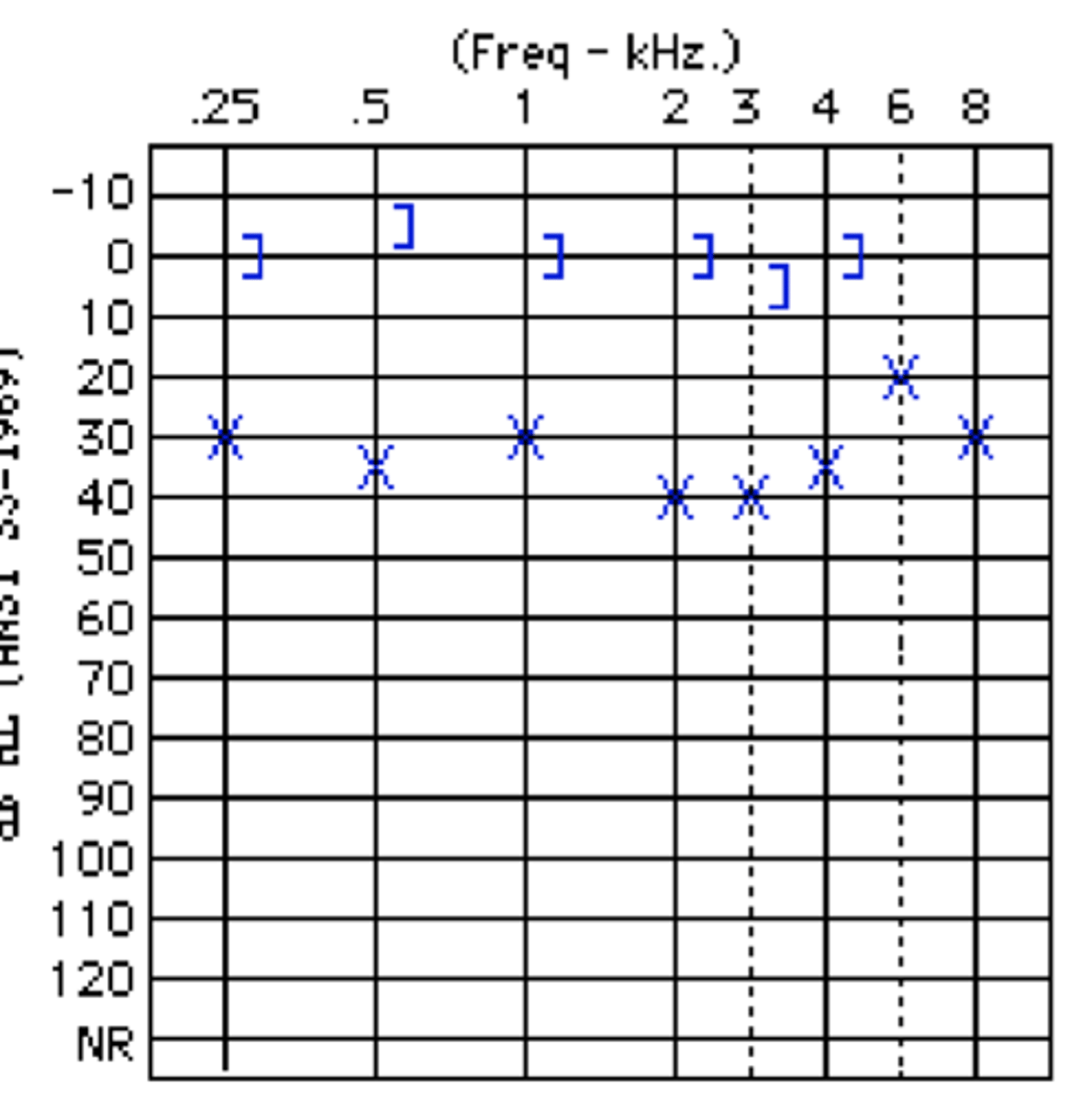
how do you determine the type of HL?
- conductive hearing loss due to a lesion in the outer and/or middle ear.
- sensorineural hearing loss due to a lesion in the inner ear and/or auditory nerve.
- mixed hearing loss due to a lesion in the outer and/or middle ear AND a lesion in the inner ear and/or auditory nerve.
at EACH frequency and for EACH ear, calculate what?
1) the amount of hearing loss by air conduction (AC thresholds).
2) the amount of hearing loss by bone conduction (BC thresholds).
3) the relationship between AC and BC (air-bone gap: ABG).
air conduction thresholds are affected by what?
- affected by lesions in the outer ear, middle ear, inner ear, and auditory nerve.
bone conduction thresholds are affected by what?
- only be affected by lesions in the inner ear or auditory nerve.
how does conductive HL affect AC/BC thresholds?
- middle ear is affected (MEANING AC IS IMPAIRED).
- NORMAL BC.
- cause of possible lesion could be otitis media.

how does SNHL affect AC/BC thresholds?
- inner ear is affected by (BOTH AC/BC IMPAIRED).
- BC bypasses OE/ME.
- cause of possible lesion could be meinere's.

how does mixed hearing loss affect AC/BC thresholds?
- both middle and inner ear affected (AC/BC IMPAIRED).
- two impedance blocks.
- more impairment in AC than BC.
- cause of possible lesion could be later stage of otosclerosis.

how do lesions affect AC/BC?
- a lesion in the outer/middle ear (such as otitis media) will affect the air conduction threshold as the pure tone must travel through the middle ear. the middle ear lesion will attenuate the pure tone causing hearing loss by air conduction.
- this same lesion, however, will have no effect on the bone conduction threshold as the bone conducted signal will travel through the temporal bone directly to the inner ear. it will bypass the outer and middle ears. so a lesion in the middle ear will have no effect on the bone conducted signal.
how do you determine a conductive loss?
- if air conduction shows hearing loss and bone conduction is normal then there is an air-bone gap and a conductive loss.
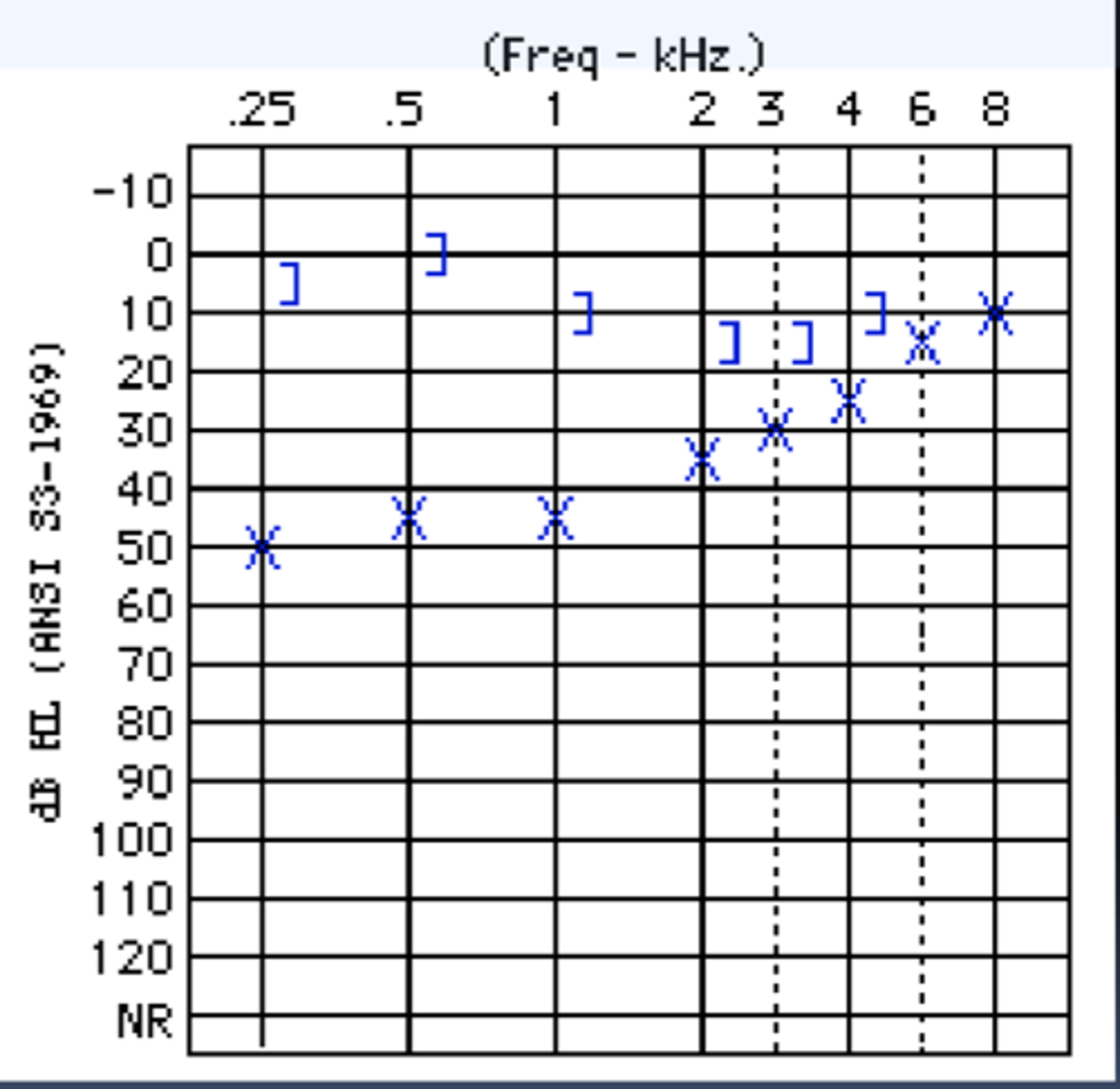
how do you determine a sensorineural loss?
- if both air conduction and bone conduction thresholds show hearing loss and the ABG <10 dB (less than or equal to), there is a sensorineural loss.
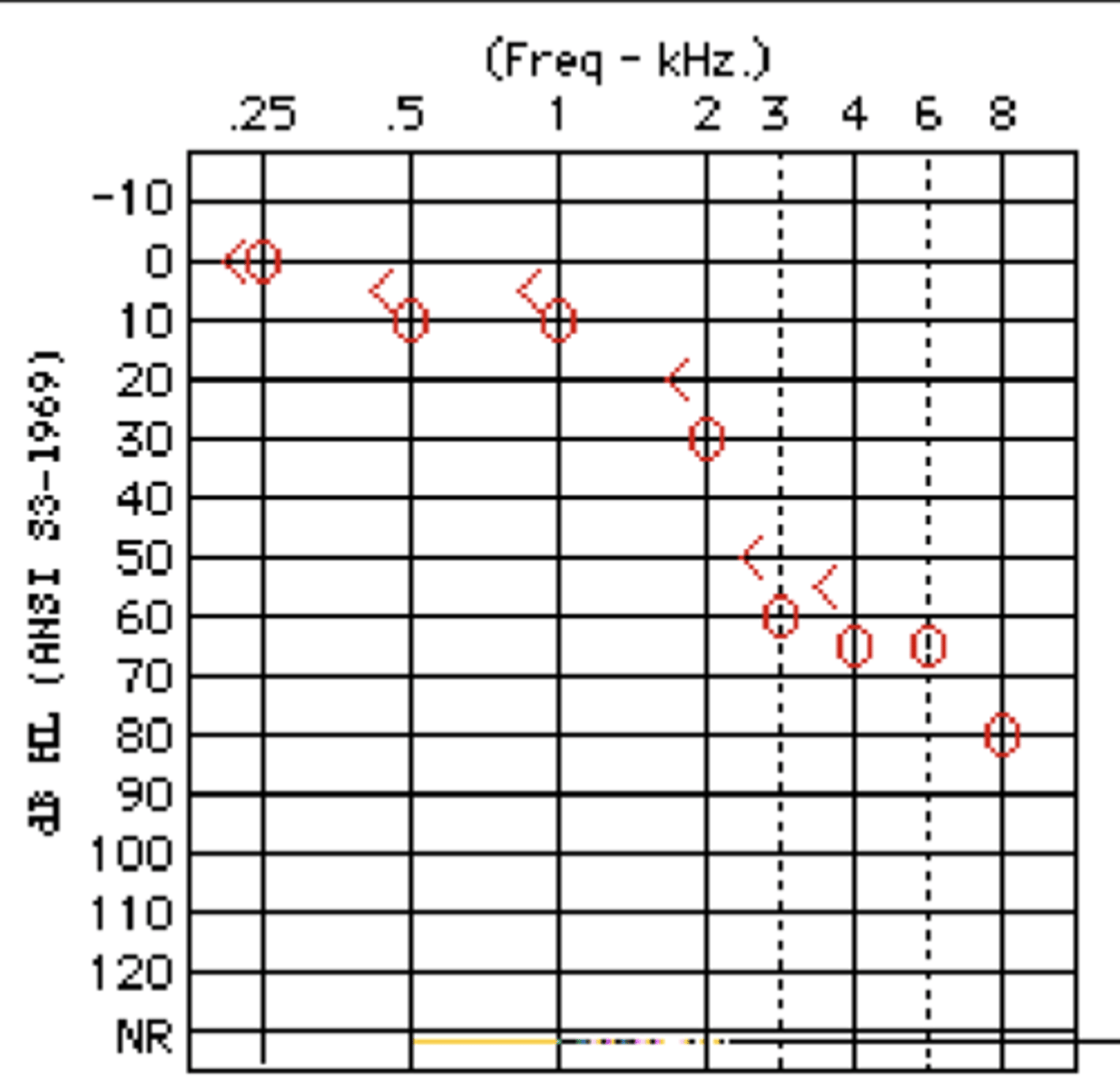
how do you determine a mixed hearing loss?
- if both air conduction and bone conduction thresholds show hearing loss and the ABG >10dB (greater than), there is a mixed hearing loss.
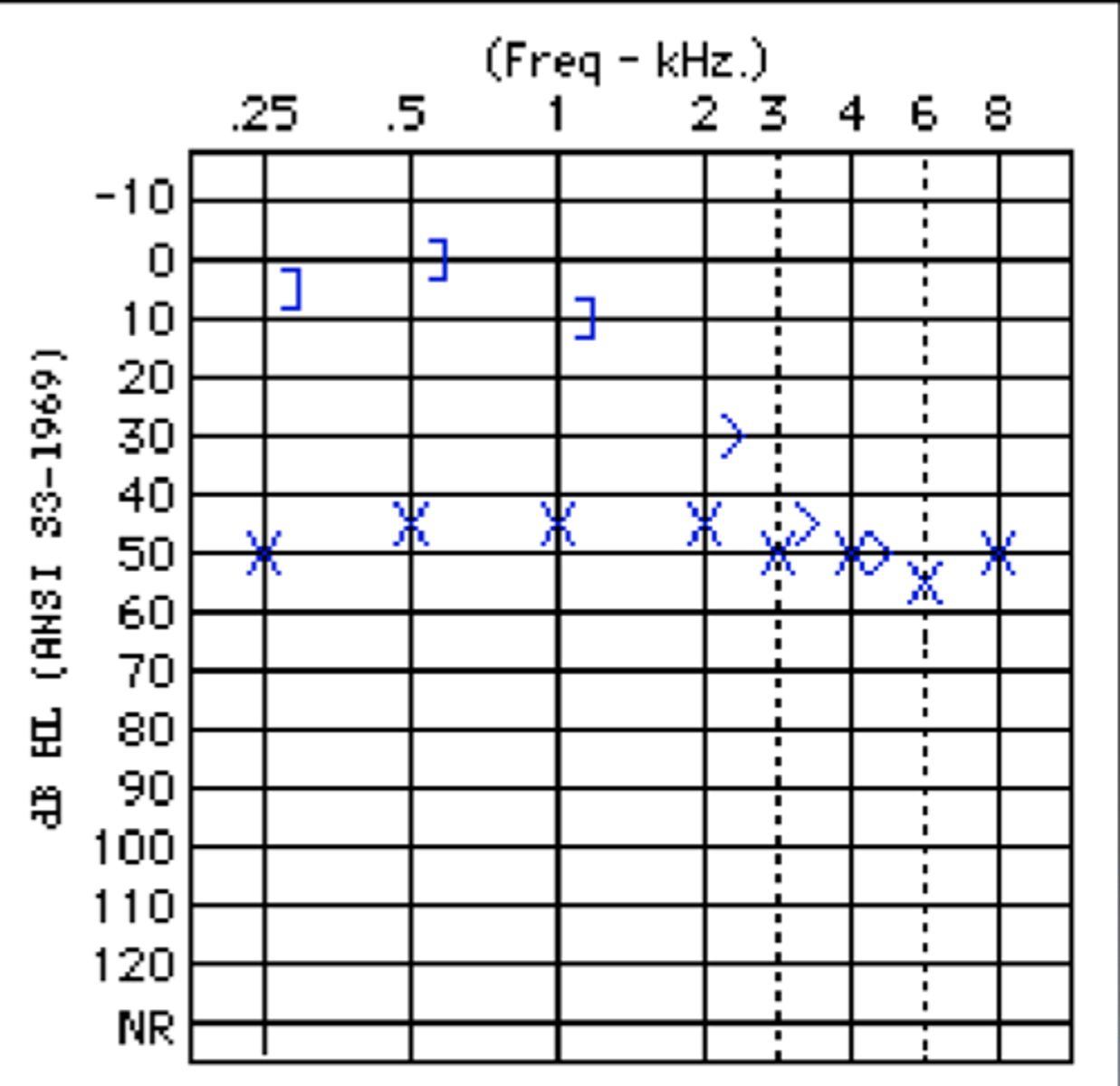
what is TE?
- test ear, usually the poorer ear.
what is NTE?
- non-test ear, the better ear.
what is crossover?
- the phenomenon in which sound energy presented to one ear (test ear) may ultimately reach the opposite ear (non-test ear).
1) sound energy (earphone) strikes the skull as it travels into the ear canal.
2) some of the energy causes the skull to vibrate.
3) cochlea is embedded within the temporal bone, vibration of the skull will cause vibration of the fluids in both cochleas.
4) the non-test ear can ultimately be stimulated during this process.
what is IA?
- the loss of sound energy (and thus intensity) as it crosses from the test ear to the non-test ear.
- an air conducted signal will lose at least 40 dB.
- IA for AC = 40 dB
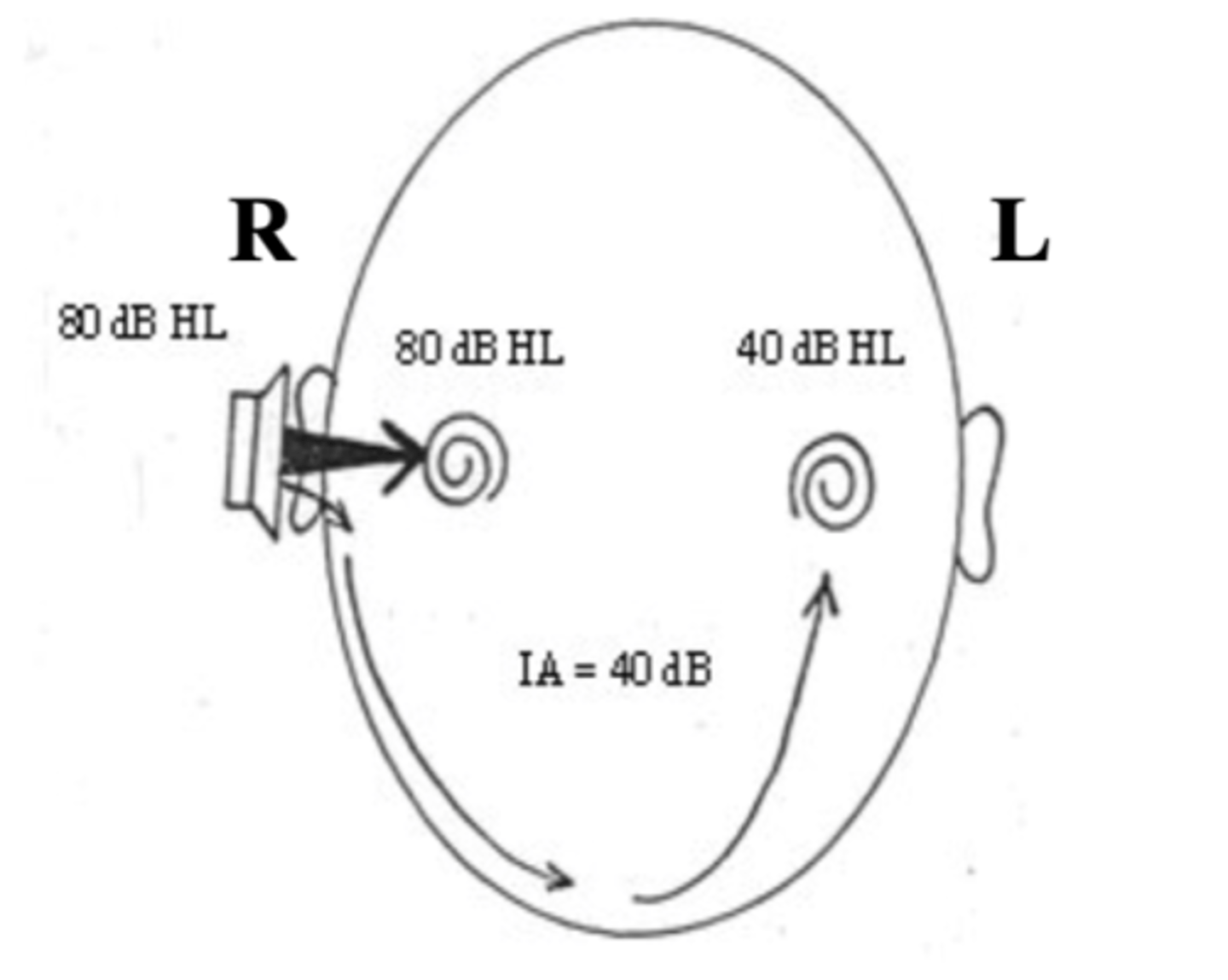
what is IA-BC?
- since the BC oscillator actually vibrates the entire skull, placing it at any place on the skull can stimulate either cochlea.
- therefore, the inter aural attenuation for bone conduction testing is 0 dB.
THERE IS NO LOSS OF SOUND ENERGY, THE SAME AMNT OF ENERGY REACHES BOTH COCHLEAS. THE ENTIRE SKULL IS VIBRATING.
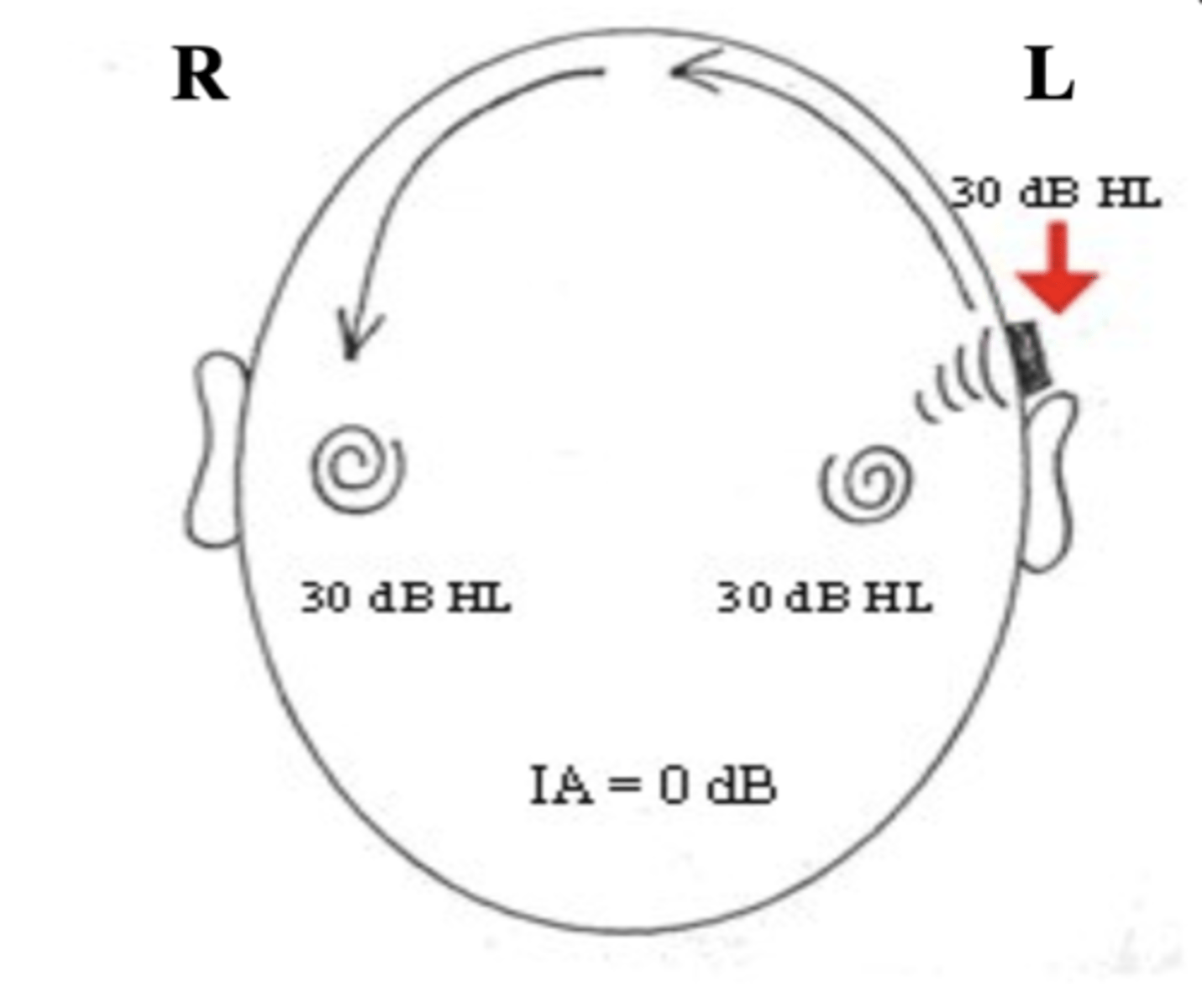
what is true about crossover?
- it is always occurring, it is not threshold specific!!!
what is cross hearing?
- occurs when the signal that has crossed over via the skull is of sufficient intensity to be audible in the opposite ear.
- via BC pathway.
- threshold-specific.
why is it important to assess the presence of cross-hearing?
- it can introduce a source of error in our testing in that we may not know, in some situations, which ear we are actually testing.
- we also do not know what the true threshold of the test ear is.
when is cross hearing a threat?
- when the air conduction threshold in the test ear minus the inter aural attenuation value is greater than or equal to the bone conduction threshold in the non-test ear, cross hearing is a threat to the validity of the results for the test ear.
if AC(TE) - BC(NTE) ≥ 40 then cross hearing is threat, and the threshold isn't real, and if masked, it would be significantly lower.
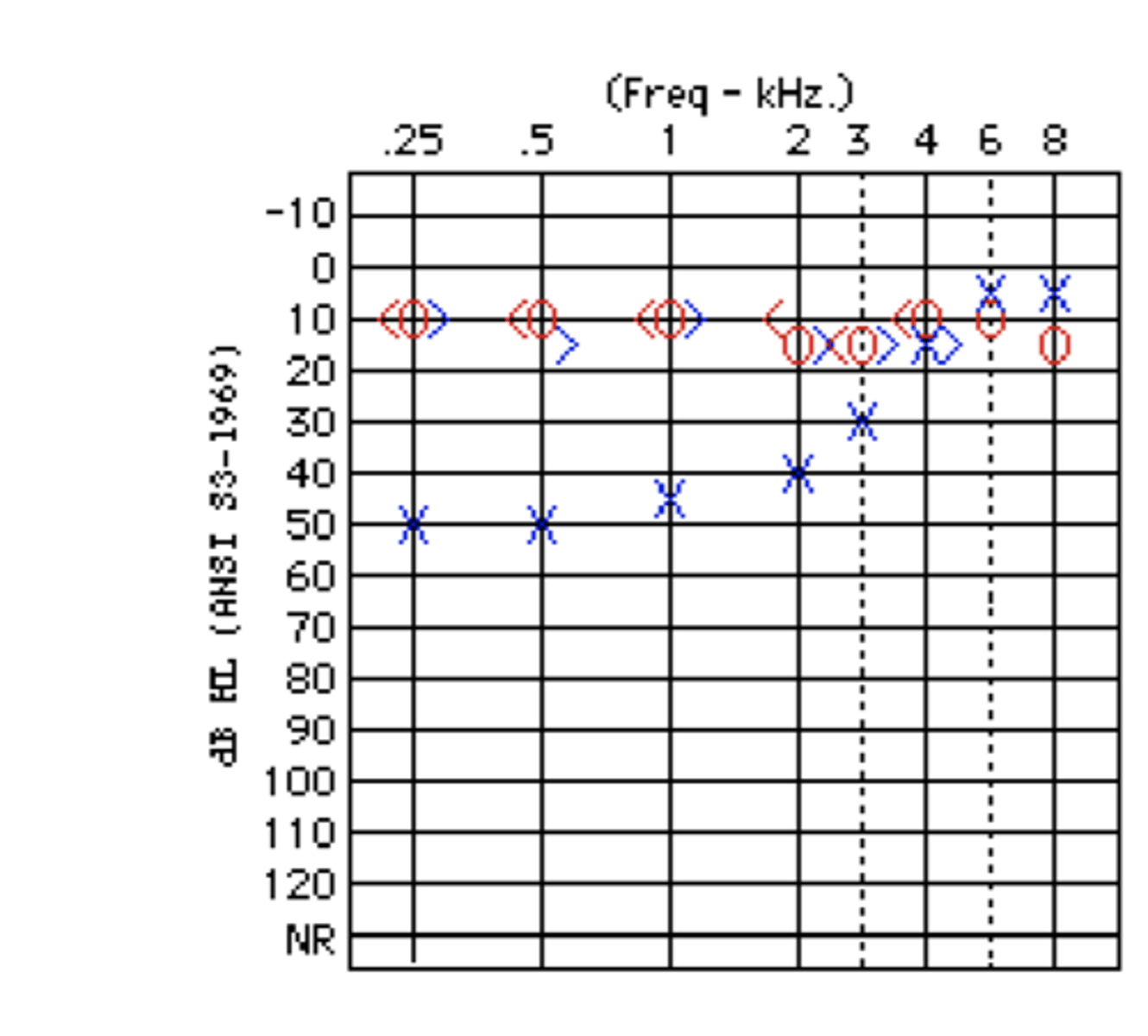
what is the relationship between BC and cross hearing?
- since the inter aural attenuation value for bone conduction is 0 dB, cross hearing is always a threat when testing by bone conduction.
- in other words, it doesn’t matter where we place the bone conduction oscillator, the cochlea with the better hearing will always respond first.
- when there is an air/bone gap of greater than 10 dB in the test ear then cross hearing is a threat to the accuracy of our results.
AC(TE) - BC(TE) > 10 then cross hearing is a problem (POOR EAR)
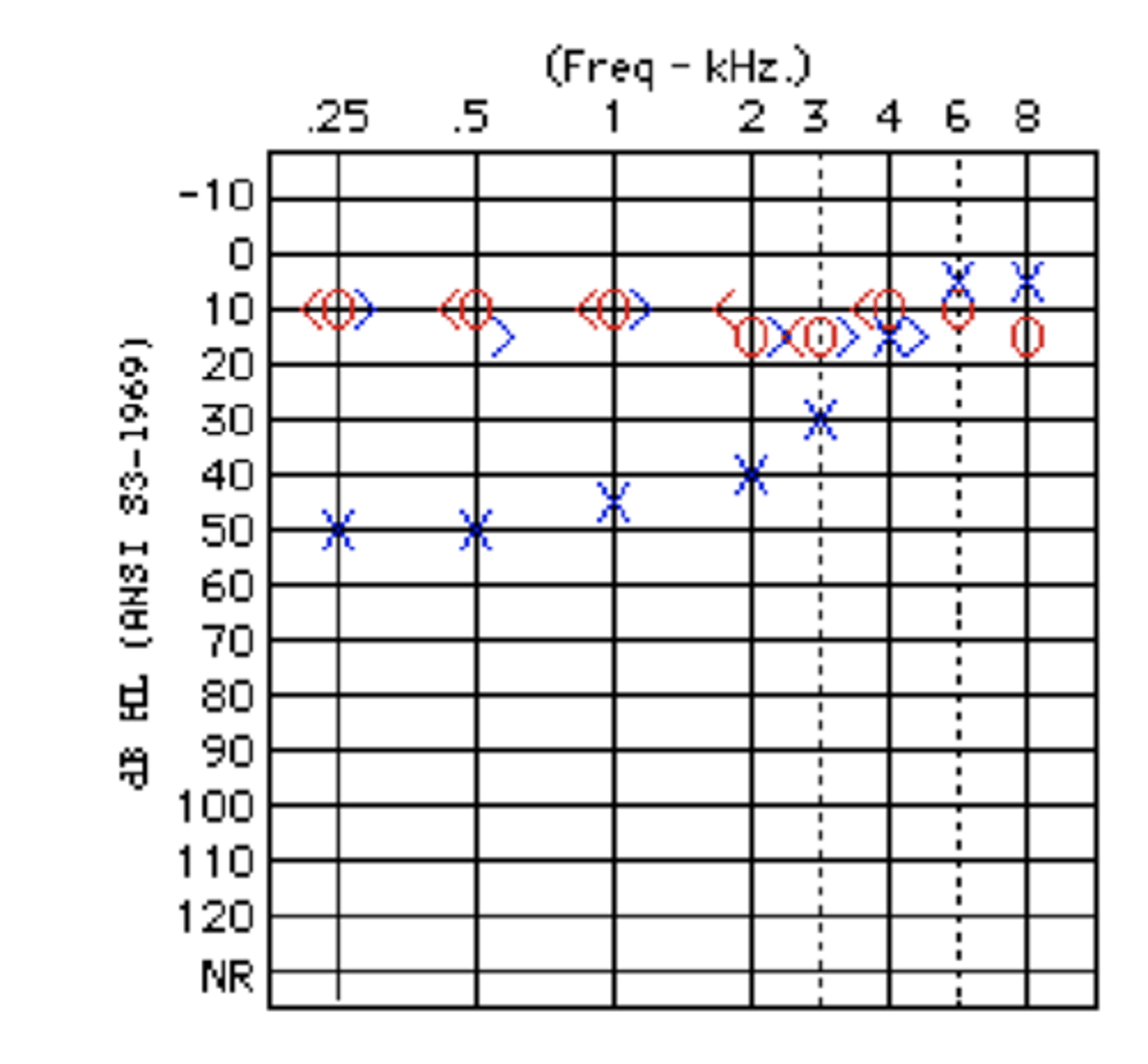
what is masking?
- applying noise to the non-test ear to keep it from responding while testing the test ear.
who is the masker?
- (usually) noise presented to the NTE (BETTER EAR).
who is the maskee?
- (usually) pure tone presented to the TE (POOR EAR).
what is the critical band?
- the area over which hair cells are stimulated for a pure tone stimulus.
- the critical band for 1000 Hz is +/- 70Hz =
930-1070 Hz (1000-70/1000+70)
what does it mean to occupy the critical band?
- if we want to mask the perception of a particular pure tone (the maskee) we need to introduce a masking signal that will 'occupy' all hair cells within the maskee's critical band (e.g., 930-1070 Hz).
what is narrow band noise?
- the most optimal to use!
- all energy concentrated within the critical band of the maskee.
- best compromise between masker efficiency and masker loudness.
masker loudness – important consideration because of loudness recruitment (abnormal growth of loudness in individuals with SNHL).
what is wide band noise?
- not very efficient in masking pure tones, as it covers more than the critical band width.
- only energy within the critical band will contribute to masking.
- all of the energy that falls outside the critical band will only contribute to the loudness of the signal; not its masking efficiency.
can we use pure tones to mask critical band noise?
- no, it only masks on frequency.
- not very efficient in masking pure tones.
- small differences in phase and frequency between the maskee and masker will affect the efficacy of the masking tone.